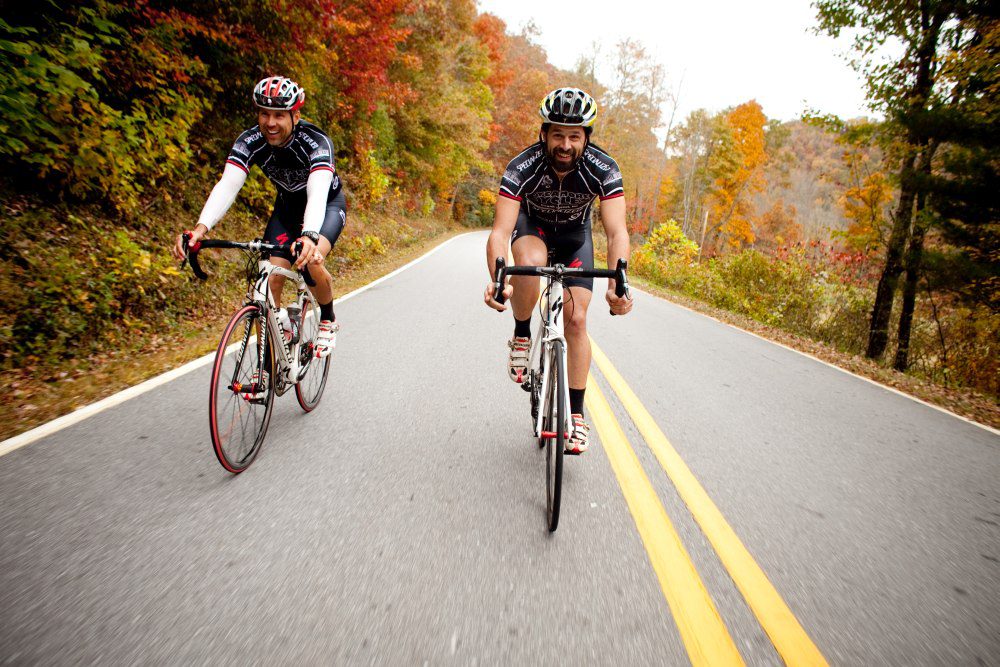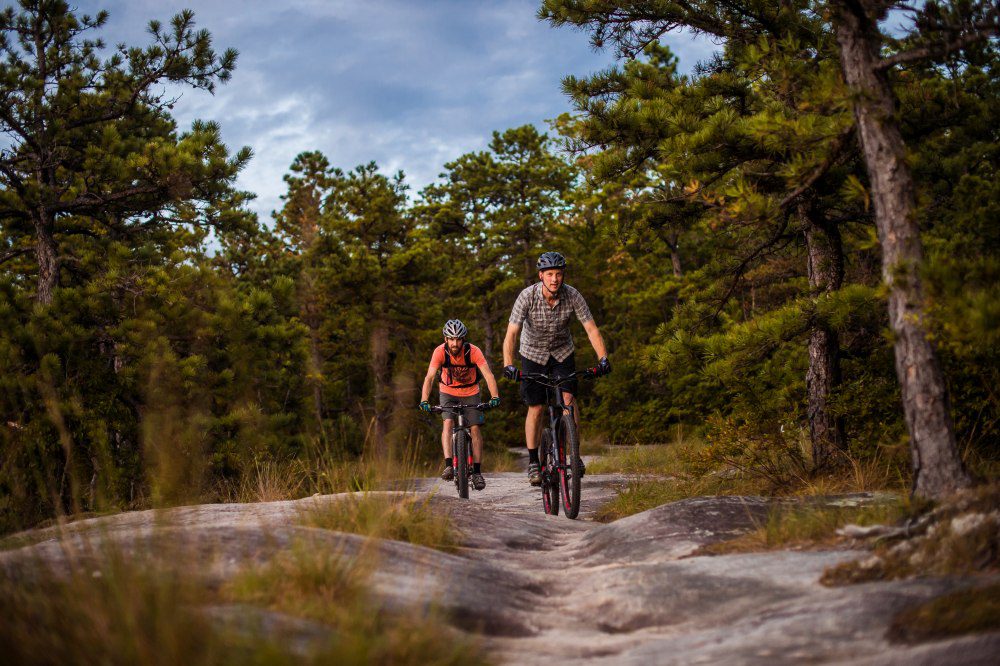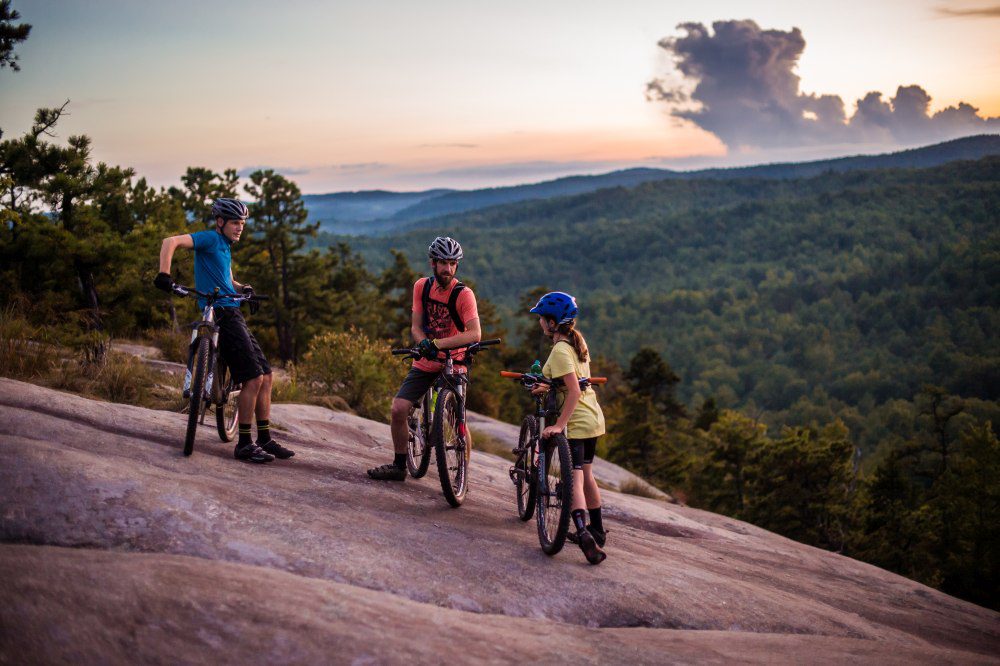A guide to cycling in North Carolina
The cycling in North Carolina lures both cyclists and mountain bikers because of the mountainous geography and milder spring forecasts.

by Tara Nolan

Even if you’re a hard-core cyclist who steadfastly plows through the winter months no matter the weather, riding in milder temps is decidedly more pleasant than having to contend with snow and slush and icy conditions. Mountain bikers usually have a bit of a wait before trails have dried out and become rideable again. Of course, our West Coast friends don’t seem to have the same spring weather extremes. They’re enjoying the cherry blossoms while those in Southern Ontario, Quebec and Manitoba are still keeping their snow tires on the car—just in case. The cycling in North Carolina is worth a little road-trip research if you want to ditch the trainer. The region’s mountainous geography (meaning lots and lots of climbing opportunities) and milder spring forecasts lure both cyclists and mountain bikers who want to clock some late-winter/early spring kilometres before adequate weather conditions usher in the season at home.
>> Related: How to make the most of your spring training trip south of the border
Follow the path of the elites
This year, provincial coach Sean Kelly took 25 road, track and mountain bike athletes to his North Carolina Endurance Camp at the Mountain Retreat and Learning Center in Highlands. “Most of the training is done on the road, focusing on getting in quality miles and lots of elevation gain,” says Kelly.
Loops are mapped out around the accommodations. “There is a bit of an art to building route plans for three groups on the road each day, but we put our heads together, use maps, local knowledge, recon many roads and rely on past experience,” says Kelly who says the riding in North Carolina is ideal. “The roads are interesting, fun and challenging, while giving us the ability to gain 300 to 500 m of elevation per hour of riding.”
Find your loops
According to Kelly, “Locals are all super friendly and willing to share their favourite trails and loops.”
Transylvania County boasts hundreds of well-paved, relatively quiet roads. The website outlines rides categorized from easy to hard, from the 44-km “Spin N’ Grin” course to the 100 km “Assault on the Carolinas” route that you can sync to your Garmin.
If you’re heading down on your own, you might want to hook up with a local cycling group or check out a club’s website to see if it offers suggested routes. The North Carolina Bicycle Club, for example, has a list of archived “cue sheets” that outline suggested routes throughout the state turn by turn, as well as the distance covered.
The Blue Ridge Bicycle Club also schedules multiple group rides and offers more than 225 cue sheets on its website, put together by Ralph Draves, a “sommelier of cycling.” To view these ride guides, you’ll need to pay the $25 signup fee, but an example that includes the Blackberry Pie route can be found on the Visit North Carolina tourism page.
More North Carolina cycling maps
Head south with a club

For the past few years, Toronto’s Morning Glory Cycling Club has been heading to Boone to take part in a cycling camp. “The idea was to go somewhere with big hills,” says Ottawa-based graphic designer Mike Zikovitz, who has twice attended the camp. “It’s a chance to get a little bit farther south in the spring and get some nicer weather,” he explains. Zikovitz describes beautiful, rural countryside with roads that are in spectacular condition and rides led by top-notch professional coach Max Shute of CTS. There also happens to be a lot of farm dogs that enjoy chasing cyclists who ride by.
As Zikovitz explains it: “Our guides know the area and they knew where the dogs would be. All of a sudden, one of the guides would take off from the front of the pack. We’d see him five minutes later distracting a dog at the side of the road so we could all ride by.” Despite this “hazard,” which can also be remedied with a sharp squirt from the water bottle, Zikovitz recommends going to North Carolina for a dose of spring riding.
Discover sweet singletrack

Varying degrees of climbing seem to be a common denominator when it comes to riding in North Carolina, but you can choose different types of trails depending on what you like to ride. For example, Tsali Recreation Area in Western North Carolina is known for its hardpacked, flowy singletrack.
Derek Zandstra, a member of the Scott-3 Rox Racing team, usually trains in North Carolina in February and March. “There is a big variety of trails from extreme downhills to fast-flowing trails,” he explains. “You can ride trails with some pretty long rock faces; there is lots of climbing, but always a well-deserved reward with a scenic overlook followed by a sweet downhill,” he says. Zandstra prefers the DuPont State Recreational Forest trail system because it’s a bit more XC-oriented and trails are in better condition in early February when he’s there. “The Big Rock trail is always neat and fun to ride,” he says.
Pisgah National Forest is more mountainous. Melinda Davie, who founded the women’s mountain biking club, the Wild Bettys, participated in the Pisgah Mountain Bike Stage Race in 2012 and 2013. Davie particularly enjoyed Squirrel Gap and Farlow Gap. “The whole area has tremendous riding,” she says.
“I would go back to Pisgah in a heartbeat,” raves fellow Wild Betty Lisa Fender, who did the Pisgah Enduro race during her visit. Fender likes to seek out challenging trails and discovered some favourites in the Davidson River District. “The cross country is a mix of flowy, off-camber and rocky tech, and the downhills start with a good hour climb and pay off with trails that range from flowy to white-knuckle descents,” she says. “I really enjoyed trails like Black Mountain and Avery Creek.”
When asked what he would compare North Carolina riding to, Zandstra says B.C., with its big rock faces and mountains, but without the big cedars and moss. “In the summer, you get all the wonderful colours of eastern North America’s trees making it amazing to ride.”
The Hub in Pisgah seems to be the place to go for gear, beer and trail info. And if you’ve never been before and would appreciate a guide, check out The Bike Farm, an eco-resort that provides shuttles and guides to the area’s trails.


